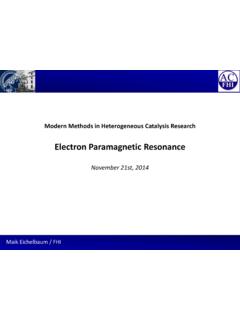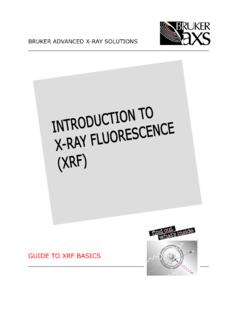Transcription of Raman spectroscopy: Basic principles and applications
1 Christian HessRaman spectroscopy : Basic principles and applications Basic principles - Resonance Raman scattering - Surface Enhanced Raman Scattering (SERS) instrumentation -Spectrometer- Excitation sources Raman in catalysis- In situ cells- In situ Raman (of working catalysts) Raman (1928) Basic principles - Resonance Raman scattering - Surface Enhanced Raman Scattering (SERS) instrumentation -Spectrometer- Excitation sources Raman in catalysis- In situ cells- In situ Raman (of working catalysts)C. Hess, 2006 Why Raman spectroscopy ? Information on rotational and vibrationallevels Raman effect small but accessible by use of lasers Complementaryinformationto IRspectroscopyphomonuclear diatomic molecules, low frequency range In situ analysisof organic and inorganic compounds Analysis of aqueous solutions and solids(powders) Using resonance and surface enhancement effects ~1010pTrace gas/single molecule analysis- molecular structureIntroductionC. Hess, 2006 Spatial charge separation under influence of electric fieldEpinduced dipole moment : = E(1) : polarizabilitypExample: polarizability changes during CO2vibrationsClassical descriptionC.
2 Hess, 2006 Example: Polarizability changes CO2 Vibrational modes of CO2C. Hess, 2006 Example: Polarizability changes CO2 Vibrational modes of CO2C. Hess, 2006 Spatial charge separation under influence of electric fieldEpinduced dipole moment : = E(1) : polarizability Electric fieldEdue to electromagn. wave with frequency 0E= E0cos 2 0t(2) p = E0cos 2 0t (3)pemission of light at same frequency 0pI= (2/3c3) * *== (16 4 2E02/3c3) 04(4)Classical description222 dtd C. Hess, 2006 Internal vibrational motion with EigenfrequencyvMq= q0cos 2 Mt(5) Polarizability pdevelop in series = q=0+ ( / q)q=0q+ higher order terms(6)p = E(7)= ( q=0+ ( / q)q=0q0cos 2 Mt) E0cos 2 0t= q=0E0cos 2 0t+ ( / q)q=0q0E0[cos 2 ( 0 - M)t+ cos 2 ( 0+ M)tRayleigh Stokes/Anti-StokesClassical descriptionC. Hess, descriptionStokesAnti-StokesRayleighinel astic impactinelastic impactelastic impact EM= 0 EM< 0 EM> 0 = 0 vib< 0 = 0 vib> 0 = 0 = 0 = 1 = 0 = 1 = 0 = 1 = 0 = 1h 0h( 0 - vib)h 0h( 0 + vib)h 0h 0h 0h 0~~~~~~~~~~~~~~~~~~~~~~~~~~~~~~~~pharmon ic oscillator: v= 1C.]
3 Hess, 2006 Raman intensity?pIs= Ni R(i f) IL(8) Ni: initial state population R(i f): Raman cross section for transitionEi EfIL: Laser intensitypthermal equilibrium: Boltzmann distribution for stateNiat TNi= N0exp(-ih vib/kT)(9)plower energy state: higher initial state populationI(Stokes) > I(Anti-Stokes) descriptionpExample: Stokes/Anti-Stokes intensities of CHCl3C. Hess, descriptionStokesAnti-Stokes-800-4000400 800020000400006000080000 IntensityRaman shift (cm-1)514nm excitation neat CHCl3C. Hess, 2006 Basic principles - Resonance Raman scattering- Surface Enhanced Raman Scattering (SERS) instrumentation -Spectrometer- Excitation sources Raman in catalysis- In situ cells- In situ Raman (of working catalysts)C. Hess, 2006 introduction to Resonance Raman scatteringpPolarizability tensor (single e state):: , Electric dipole moment operator with incident/scattered light + =viwwgevevgev0g0ev,0 11 h {{{{{{{{{{{{{{{{{{{{{{{{Gas inlet Gas outlet Thermocouple wellQuartz chips O-ringHigh-temperaturecementQuartz woolHeating wireQuartz windowSample {{{{{{{{{{{{{{{{{{{{{{{{Gas inlet Gas outlet Thermocouple wellQuartz chips O-ringHigh-temperaturecementQuartz woolHeating wireQuartz windowSample non-resonant Ramang1g0 Stokesresonance virtual levelVisresonant Ramang1g0 Stokeselectronic resonance virtual levelVisevC.}}}}}}}}}}}}}}}}}}}}}}}}}}}} }}}}}}}}}}}}}}}}}}}}
4 Hess, 2006 {{{{{{{{{{{{{{{{{{{{{{{{Gas inlet Gas outlet Thermocouple wellQuartz chips O-ringHigh-temperaturecementQuartz woolHeating wireQuartz windowSample {{{{{{{{{{{{{{{{{{{{{{{{Gas inlet Gas outlet Thermocouple wellQuartz chips O-ringHigh-temperaturecementQuartz woolHeating wireQuartz windowSample non-resonant Ramanv=1v=0 Stokesresonance virtual levelVisresonant Ramanv=1v=0 Stokeselectronic resonance virtual levelVisExample: -Carotin514nm632nmWavelength (nm)AbsorbanceC. Hess, 2006 Example: -CarotinC=C stretch040080012001600200001000020000300 00 IntensityRaman shift (cm-1) -carotin, 9mW, 20s exp 514nm excitation 632nm excitationenhancementfactor = 10C. Hess, 2006 Basic principles - Resonant Raman spectroscopy - Surface Enhanced Raman Scattering (SERS) instrumentation -Spectrometer- Excitation sources Raman in catalysis- In situ cells- In situ Raman (of working catalysts)C. Hess, 2006 introduction to SERS Normal Raman scatteringI( L)N molecules with R,freeI( S)INRS( S) = N I( L) R,freeC.}}}}}}}}}}}}}}}}}}}}}}}}}}}}}}}} }}}}}}}}}}}}}}}}
5 Hess, 2006 SERS mechanism - enhancement factorsSurface-enhanced Raman scatteringI( L) A( L)2N with R,ads, N NI( S) A( S)2 ISERS( S) = N I( L) A( L)2A( S)2 R,ads Rough metal nanostructure(1) field enhancement(2) Chemical enhancementmax. 10-100max. ~ 106(isolated Ag,Au)rdMoleculemetal 0EM( )A( )=E0( )max. ~ 108(coupled) C. Hess, 2006 {{{{{{{{{{{{{{{{{{{{{{{{Gas inlet Gas outlet Thermocouple wellQuartz chips O-ringHigh-temperaturecementQuartz woolHeating wireQuartz windowSample {{{{{{{{{{{{{{{{{{{{{{{{Gas inlet Gas outlet Thermocouple wellQuartz chips O-ringHigh-temperaturecementQuartz woolHeating wireQuartz windowSample SERS substrateSEM images of the silver nanowire ML on Si waferDDeposited ML shows domains of aligned silver nanowiresA. Tao, F. Kim, C. Hess, J. Goldberger, R. He, Y. Sun, Y. Xia, P. Yang, Nano Lett. 3 (2003) 1229 {{{{{{{{{{{{{{{{{{{{{{{{Gas inlet Gas outlet Thermocouple wellQuartz chips O-ringHigh-temperaturecementQuartz woolHeating wireQuartz windowSample {{{{{{{{{{{{{{{{{{{{{{{{Gas inlet Gas outlet Thermocouple wellQuartz chips O-ringHigh-temperaturecementQuartz woolHeating wireQuartz windowSample SERS substrateUV-VIS absorption spectra of silver nanowire MLDB roadened extinction 500-600 nm due to wire-wire couplingtransverselongitudinalRaman {{{{{{{{{{{{{{{{{{{{{{{{Gas inlet Gas outlet Thermocouple wellQuartz chips O-ringHigh-temperaturecementQuartz woolHeating wireQuartz windowSample {{{{{{{{{{{{{{{{{{{{{{{{Gas inlet Gas outlet Thermocouple wellQuartz chips O-ringHigh-temperaturecementQuartz woolHeating wireQuartz windowSample SERS example: 1-hexadecanthiol/Ag-LB film (C-S)t (C-C)CH3rockCH2wagCH2twist/scissor Enhancement factor EF:EF = [ISERS]/[IRaman] [Mb]/[Mads] thiol head group ( )2, closed-packed layerDmolecule conc.}}}}}}}}}}}}}}}}}}}}}}}}}}}}}}}}}}} }}}}}}}}}}}}}}}}}}}}}}}}}}}}}}}}}}}}}}}} }}}}}}}}}}}}}}}}}}}}}}}}}}}}}}}}}}}}}}}} }}}}}}}}}}}}}}}}}}}}}}}}}}}}}
6 On 1014/cm2D532nm, band at 1295 cm-1 DEF = 2 105C. Hess, 2006 {{{{{{{{{{{{{{{{{{{{{{{{Gas inlet Gas outlet Thermocouple wellQuartz chips O-ringHigh-temperaturecementQuartz woolHeating wireQuartz windowSample {{{{{{{{{{{{{{{{{{{{{{{{Gas inlet Gas outlet Thermocouple wellQuartz chips O-ringHigh-temperaturecementQuartz woolHeating wireQuartz windowSample SERRS example: Rhodamine 6G/Ag-LB filmSERRS = Surface Enhanced Resonance Raman Scattering Large EF = 109as result of SERS andResonant Raman Linear relationship between intensity and concentrationDsurface not saturated Langmuirdescription usingMads= Mads,maxKa0/(1+Ka0)yields Gads= 46 KJ/molC. Hess, 2006 Basic principles - Resonant Raman spectroscopy - Surface Enhanced Raman Scattering (SERS) instrumentation -Spectrometer- Excitation sources Raman in catalysis- In situ cells- In situ Raman (of working catalysts)C. Hess, 2006 Raman spectrometer Triple spectrograph first 2 gratings subtractivepremoval Rayleigh (40% E) grating 3/4 creates dispersion detection.}}}}}}}}}}}}}}}}}}}}}}}}}}}}}} }}}}}}}}}}}}}}}}}}
7 Diode arrayChallenges to record (good) spectra Separate inelastically scattered from Rayleigh ( ) light Collect the maximum number of inelastically scattered photonsFourier Transform (FT) - Raman Michelson interferometer (Jacquinot, multiplex) NIR ( m) excitation, pless fluorescence pself absorptionModern Raman spectrometerLight source(Laser)Dispersion gratingDetector(CCD)samplesampling optics(objective, immersion probe)Notchfilter holographicnotchfiltersp80% T of Ramanlight,324 -1339 nm available singletransmissiongratingp0 -4400 cm-1(multiplex) clean , no moving parts, high light throughput cooledCCD (~ 40% QE)p400 -1000 nm detection Basic principles - Resonant Raman spectroscopy - Surface Enhanced Raman Scattering (SERS) instrumentation -Spectrometer- Excitation sources Raman in catalysis- In situ cells- In situ Raman (of working catalysts)C. Hess, 2006 Laser excitation wavelengthsFluorescence(organic samples/water)choice of laser wavelength: scattering intensity ~ 4 detectors resonance enhancement self-absorption of sample fluorescence (pNIR, UV)(typical range) Basic principles - Resonant Raman spectroscopy - Surface Enhanced Raman Scattering (SERS) instrumentation -Spectrometer- Excitation sources Raman in catalysis- In situ cells- In situ Raman (of working catalysts)C.
8 Hess, 2006In situ Raman cells {{{{{{{{{{{{{{{{{{{{{{{{Gas inlet Gas outlet Thermocouple wellQuartz chips O-ringHigh-temperaturecementQuartz woolHeating wireQuartz windowSample {{{{{{{{{{{{{{{{{{{{{{{{Gas inlet Gas outlet Thermocouple wellQuartz chips O-ringHigh-temperaturecementQuartz woolHeating wireQuartz windowSample {{{{{{{{{{{{{{{{{{{{{{{{ Raman -scattered light Gas inlet Gas outlet Thermocouple wellQuartz chips O-ringHigh-temperaturecementQuartz woolHeating wireQuartz windowSample Laser excitation atlow laser power tominimize heating Raman cell design mimics plug-flow reactor: gases flow through catalyst bed 50 100 mg samplePlug-flow reactorC. Hess, 2006In situ Raman cellsFluidized bed reactor Particle motionpreduces laser beam exposure Raman cell mimics fluidized bed reactor: gases flow through catalyst bed UV laser excitation ~200 mg sampleIn situ Raman cellsRotating Raman cell Sample rotationpreduces laser beam exposure Gas flow over catalyst bed ~200 mg sample Requires pellets Basic principles - Resonant Raman spectroscopy - Surface Enhanced Raman Scattering (SERS) instrumentation -Spectrometer- Excitation sources Raman in catalysis- In situ cells- In situ Raman (of working catalysts)C.}}}}}}}}}}}}}}}}}}}}}}}}}}}} }}}}}}}}}}}}}}}}}}}}}}}}}}}}}}}}}}}}}}}} }}}}
9 Hess, 2006 The NO storage-reduction conceptXSupportBaOBaOPtPtNOO2NO2 NOBaNO3 NOO2NO2* Jang et al., Catal. Lett. 77 (2001) 1 Lower fuel consumptionby use of engines operating with excess oxygen Typical storage catalysts consist of storage material (BaO) andmetal (Pt) Problem: Reduction of NOx Solution: Storage of NOxfollowed by short rich periods for reduction BaO/Al2O3deactivatesat higher temperatures (due to Ba-Al alloying)* Focus onBaO/MgOwhich isstable up to at least 900 CC. Hess, 2006 Experimental setup: Raman spectroscopyIn situ {{{{{{{{{{{{{{{{{{{{{{{{Gas inlet Gas outlet Thermocouple wellQuartz chips O-ringHigh-temperaturecementQuartz woolHeating wireQuartz windowSample {{{{{{{{{{{{{{{{{{{{{{{{Gas inlet Gas outlet Thermocouple wellQuartz chips O-ringHigh-temperaturecementQuartz woolHeating wireQuartz windowSample {{{{{{{{{{{{{{{{{{{{{{{{ Raman -scattered light Gas inlet Gas outlet Thermocouple wellQuartz chips O-ringHigh-temperaturecementQuartz woolHeating wireQuartz windowSample Laser excitation at 532 nm,low laser power of ~6 mWminimizes heating of sample Raman cell design mimicstypicalplug-flow reactor:Gases flow through catalystbed (50 mg) at ~40 ml/minC.}}}}}}}}}}}}}}}}}}}}}}}}}}}}}}}} }}}}}}}}}}}}}}}}}}}}}}}}}}}}}}}}}}}}}}}}
10 Hess, 2006 Preparation of the 14 mol % BaO/MgO catalystJeol 2010, 200 kV, x40k200 nm Impregnationof Ba(NO3)2on MgO (Fisher) Drying at 100 C, heating at 120 C for 2h Heating to 900 C in He for 2h to decompose Ba(NO3)2and BaCO3 BaO formation confirmed by XRD TEM shows formation ofhomogeneous BaO phase X-ray analysis confirmsthe presence of BaO/MgOC. Hess, 200610501020 Raman shift (cm-1)1080 NO 400 C214001200 Raman shift (cm-1)13271337 (NO )2+Ba -NO2+2Ba(NO )32Ba -NO2+282213371327259 Formation of nitro species precedesthat of nitratesIn situRaman spectra during NO2exposureC. Hess, 200610491% NO 300 C205106030 Minutes1335135733Ba(NO )2+Ba -NO2+28251327259Ba(NO )321% NO 475 C2 Minutes0510201511048133772481430Ba -NO2+21327253 Temperature dependence 300 C:Formation of nitro species precedes nitrates (as at 400 C) 475 C:Higher rate of NO3formation but smaller storage capacity-In situRaman spectra during NO2exposureIn situ Raman spectra after catalyst pre-oxidationDependence on pre-oxidation time150010005000 Raman shift (cm-1)Minutes05101% NO 400 C225% O pre-flow: 1 min 214010521336 Ramanintensity( )Ba -NO2+21052 Ramanintensity( )150010005000 Raman shift (cm-1)Minutes051020151% NO 400 C225% O pre-flow: 4 min 21347301048Ba(NO )32Ba -NO2+21052 Pre-oxidation of BaOenables direct nitrate formation at 400 CC.


